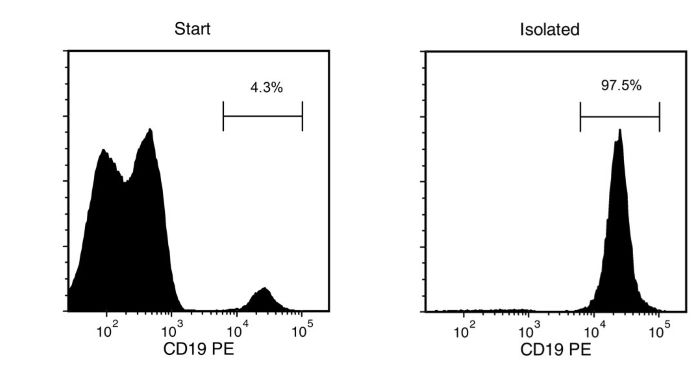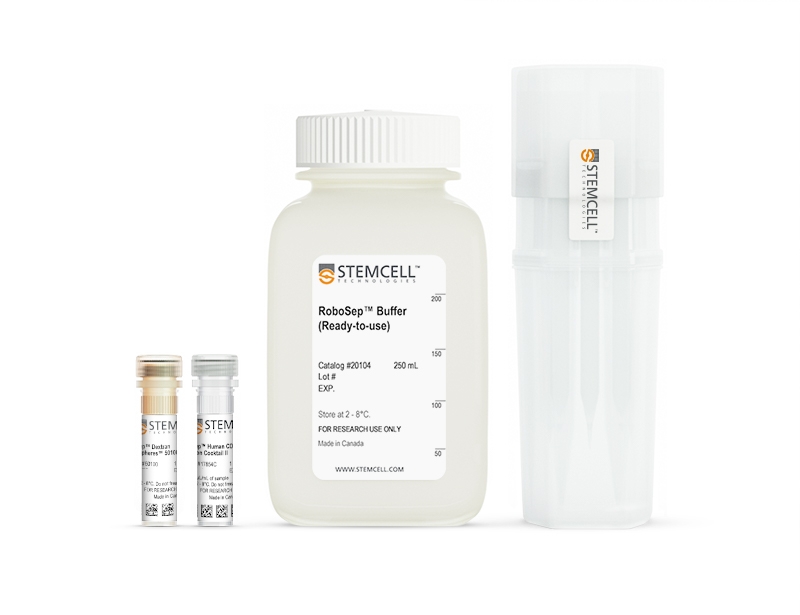概要
The EasySep™ Human CD19 Positive Selection Kit II is designed to isolate CD19+ cells from fresh or previously frozen peripheral blood mononuclear cells by positive selection. Desired cells are targeted with Tetrameric Antibody Complexes recognizing CD19 and dextran-coated magnetic particles. The cocktail also contains an antibody to human Fc receptor to minimize nonspecific binding. Labeled cells are separated using an EasySep™ magnet without the use of columns. Cells of interest remain in the tube while unwanted cells are poured off. The CD19 antigen is expressed on mature B cells and B cell progenitors but is lost upon maturation to plasma cells. It is also expressed on follicular dendritic cells.
This product replaces the EasySep™ Human CD19 Positive Selection Kit (Catalog #18054) for even faster cell isolations.
This product replaces the EasySep™ Human CD19 Positive Selection Kit (Catalog #18054) for even faster cell isolations.
技术资料
| Document Type | 产品名称 | Catalog # | Lot # | 语言 |
|---|---|---|---|---|
| Product Information Sheet | EasySep™ Human CD19 Positive Selection Kit II | 17854 | All | English |
| Product Information Sheet | RoboSep™ Human CD19 Positive Selection Kit II | 17854RF | All | English |
| Safety Data Sheet 1 | EasySep™ Human CD19 Positive Selection Kit II | 17854 | All | English |
| Safety Data Sheet 2 | EasySep™ Human CD19 Positive Selection Kit II | 17854 | All | English |
| Safety Data Sheet 1 | RoboSep™ Human CD19 Positive Selection Kit II | 17854RF | All | English |
| Safety Data Sheet 2 | RoboSep™ Human CD19 Positive Selection Kit II | 17854RF | All | English |
数据及文献
Data

Figure 1. Typical EasySep™ Human CD19 Positive Selection Profile
Starting with a single cell suspension of human PBMCs, the CD19+ cell content of the isolated fraction is typically 98 ± 1% (mean ± SD using the purple EasySep™ Magnet).
Publications (8)
Scientific reports 2020 jan
Novel genes exhibiting DNA methylation alterations in Korean patients with chronic lymphocytic leukaemia: a methyl-CpG-binding domain sequencing study.
Abstract
Abstract
Chronic lymphocytic leukaemia (CLL) exhibits differences between Asians and Caucasians in terms of incidence rate, age at onset, immunophenotype, and genetic profile. We performed genome-wide methylation profiling of CLL in an Asian cohort for the first time. Eight Korean patients without somatic immunoglobulin heavy chain gene hypermutations underwent methyl-CpG-binding domain sequencing (MBD-seq), as did five control subjects. Gene Ontology, pathway analysis, and network-based prioritization of differentially methylated genes were also performed. More regions were hypomethylated (2,062 windows) than were hypermethylated (777 windows). Promoters contained the highest proportion of differentially methylated regions (0.08{\%}), while distal intergenic and intron regions contained the largest number of differentially methylated regions. Protein-coding genes were the most abundant, followed by long noncoding and short noncoding genes. The most significantly over-represented signalling pathways in the differentially methylated gene list included immune/cancer-related pathways and B-cell receptor signalling. Among the top 10 hub genes identified via network-based prioritization, four (UBC, GRB2, CREBBP, and GAB2) had no known relevance to CLL, while the other six (STAT3, PTPN6, SYK, STAT5B, XPO1, and ABL1) have previously been linked to CLL in Caucasians. As such, our analysis identified four novel candidate genes of potential significance to Asian patients with CLL.
Scientific reports 2020 feb
Specific memory B cell response in humans upon infection with highly pathogenic H7N7 avian influenza virus.
Abstract
Abstract
H7 avian influenza viruses represent a major public health concern, and worldwide outbreaks raise the risk of a potential pandemic. Understanding the memory B cell response to avian (H7) influenza virus infection in humans could provide insights in the potential key to human infection risks. We investigated an epizootic of the highly pathogenic A(H7N7) in the Netherlands, which in 2003 led to infection of 89 persons and one fatal case. Subtype-specificity of antibodies were determined for confirmed H7N7 infected individuals (cases) (n = 19), contacts of these cases (n = 21) and a comparison group controls (n = 16), by microarray, using recombinant hemagglutinin (HA)1 proteins. The frequency and specificity of memory B cells was determined by detecting subtype-specific antibodies in the culture supernatants from in vitro stimulated oligoclonal B cell cultures, from peripheral blood of cases and controls. All cases (100{\%}) had high antibody titers specific for A(H7N7)2003 (GMT {\textgreater} 100), whereas H7-HA1 antigen binding was detected in 29{\%} of contacts and 31{\%} of controls, suggesting that some of the H7 reactivity stems from cross reactive antibodies. To unravel homotypic and heterotypic responses, the frequency and specificity of memory B cells were determined in 2 cases. Ten of 123 HA1 reactive clones isolated from the cases bound to only H7- HA1, whereas 5 bound both H7 and other HA1 antigens. We recovered at least four different epitopal reactivities, though none of the H7 reactive antibodies were able to neutralize H7 infections in vitro. Our study serologically confirms the infection with H7 avian influenza viruses, and shows that H7 infection triggers a mixture of strain -specific and cross-reactive antibodies.
The Journal of clinical investigation 2019 dec
Myalgic encephalomyelitis/chronic fatigue syndrome patients exhibit altered T cell metabolism and cytokine associations.
Abstract
Abstract
Myalgic encephalomyelitis/chronic fatigue syndrome (ME/CFS) is a complex disease with no known cause or mechanism. There is an increasing appreciation for the role of immune and metabolic dysfunction in the disease. ME/CFS has historically presented in outbreaks, often has a flu-like onset, and results in inflammatory symptoms. Patients suffer from severe fatigue and post-exertional malaise. There is little known about the metabolism of specific immune cells in ME/CFS patients. To investigate immune metabolism in ME/CFS, we isolated CD4+ and CD8+ T cells from 53 ME/CFS patients and 45 healthy controls. We analyzed glycolysis and mitochondrial respiration in resting and activated T cells, along with markers related to cellular metabolism, and plasma cytokines. We found that ME/CFS CD8+ T cells have reduced mitochondrial membrane potential compared to healthy controls. Both CD4+ and CD8+ T cells from ME/CFS patients had reduced glycolysis at rest, while CD8+ T cells also had reduced glycolysis following activation. ME/CFS patients had significant correlations between measures of T cell metabolism and plasma cytokine abundance that differed from healthy control subjects. Our data indicate that patients have impaired T cell metabolism consistent with ongoing immune alterations in ME/CFS that may illuminate the mechanism behind this disease.
Nature communications 2018 OCT
Sequencing HIV-neutralizing antibody exons and introns reveals detailed aspects of lineage maturation.
Abstract
Abstract
The developmental pathways of broadly neutralizing antibodies (bNAbs) against HIV are of great importance for the design of immunogens that can elicit protective responses. Here we show the maturation features of the HIV-neutralizing anti-V1V2 VRC26 lineage by simultaneously sequencing the exon together with the downstream intron of VRC26 members. Using the mutational landscapes of both segments and the selection-free nature of the intron region, we identify multiple events of amino acid mutational convergence in the complementarity-determining region 3 (CDR3) of VRC26 members, and determine potential intermediates with diverse CDR3s to a late stage bNAb from 2 years prior to its isolation. Moreover, we functionally characterize the earliest neutralizing intermediates with critical CDR3 mutations, with some emerging only 14 weeks after initial lineage detection and containing only {\~{}}6{\%} V gene mutations. Our results thus underscore the utility of analyzing exons and introns simultaneously for studying antibody maturation and repertoire selection.
Nature biotechnology 2018 JAN
Multiplexed droplet single-cell RNA-sequencing using natural genetic variation.
Abstract
Abstract
Droplet single-cell RNA-sequencing (dscRNA-seq) has enabled rapid, massively parallel profiling of transcriptomes. However, assessing differential expression across multiple individuals has been hampered by inefficient sample processing and technical batch effects. Here we describe a computational tool, demuxlet, that harnesses natural genetic variation to determine the sample identity of each droplet containing a single cell (singlet) and detect droplets containing two cells (doublets). These capabilities enable multiplexed dscRNA-seq experiments in which cells from unrelated individuals are pooled and captured at higher throughput than in standard workflows. Using simulated data, we show that 50 single-nucleotide polymorphisms (SNPs) per cell are sufficient to assign 97% of singlets and identify 92% of doublets in pools of up to 64 individuals. Given genotyping data for each of eight pooled samples, demuxlet correctly recovers the sample identity of<99% of singlets and identifies doublets at rates consistent with previous estimates. We apply demuxlet to assess cell-type-specific changes in gene expression in 8 pooled lupus patient samples treated with interferon (IFN)-β and perform eQTL analysis on 23 pooled samples.
Oncoimmunology 2018
Co-stimulatory signaling determines tumor antigen sensitivity and persistence of CAR T cells targeting PSCA+ metastatic prostate cancer.
Abstract
Abstract
Advancing chimeric antigen receptor (CAR)-engineered adoptive T cells for the treatment of solid cancers is a major focus in the field of immunotherapy, given impressive recent clinical responses in hematological malignancies. Prostate cancer may be amenable to T cell-based immunotherapy since several tumor antigens, including prostate stem-cell antigen (PSCA), are widely over-expressed in metastatic disease. While antigen selectivity of CARs for solid cancers is crucial, it is problematic due to the absence of truly restricted tumor antigen expression and potential safety concerns with on-target off-tumor" activity. Here

 网站首页
网站首页




